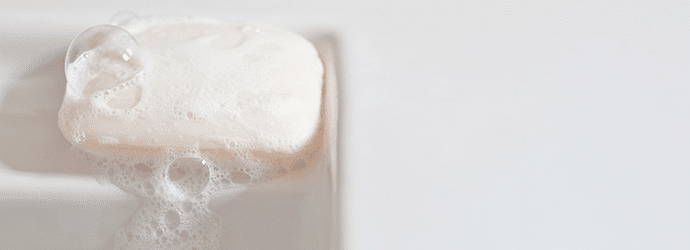Commonly, no one thinks much about how the surfaces of labware (like microcentrifuge tubes, test tubes, dishes, etc.) can affect experimental results. We might know when we need to use glass versus plastic. Or we might know that certain chemicals, like chloroform, will interact with some plastic polymers, and you must use polymers that are more resistant to melting, like polypropylene. But our consideration typically does not go much further than that. However, understanding how the surface of the materials being used interact with solutions during an experiment is very important, especially when dealing with proteins in solution.
Proteins have the ability to non-specifically adsorb or adhere onto a working surface, such as a channel, chip, container, or pipette tip. Protein adhesion results from the
structure of proteins. They contain both hydrophobic and hydrophilic regions that attract like-surfaces. Thus, a strongly hydrophobic or hydrophilic surface is an ideal culprit for protein adhesion.
Protein adhesion is very common. It is so common that a
whole body of research is dedicated to studying the occurrence of protein adhesion and how to minimize it. Protein adhesion takes place whenever a protein comes into contact with a hydrophobic surface (like plastics and polymers) or a hydrophilic surface (like glass). When the number of laboratory experiments that use glass, plastics, and plastic-based polymers are taken into consideration, you can easily see how often protein adhesion occurs in the laboratory.
How Protein Adhesion Affects Your Experiments
Is the widespread occurrence of protein adhesion a cause for concern? How may it affect your experiments? Here are some examples of how protein adhesion can affect your experiment.
Concentration
Protein adhesion directly affects measurement of the concentration of your target protein. An unknown portion of the protein sticking to a glass or plastic surface will change the final concentration. This results in the loss of important molecules and incorrect concentration reads. It is also difficult to remove adhered proteins, making it difficult to determine how much of the target protein has been lost.
Protein Structure
Another concern is that, upon binding to various surfaces, proteins may change their shape to assume a more thermodynamically favorable conformation. For example, a protein may change morphology to expose more hydrophilic sites to a hydrophilic surface. As we know, structure affects function and vice versa. So, this change in conformation can alter the biological activity of the adsorbed protein in solution, which in turn could affect experiments measuring protein reactivity. Similarly, a change in protein conformation due to adsorption could lead to a change in oligomer or ligand affinity between target proteins, affecting the results observed.
Channel Clogging
One effect of protein adhesion that has technical consequences is that it can clog channels. Devices that are reused can hold on to protein particles previously adsorbed, contaminating future experiments. In the biomedical industry, this prominent issue has been termed biofouling.
What You Can Do About Protein Adhesion
Minimizing protein adhesion is vital in avoiding the above scenarios impacting your experiments. However, before protein adhesion can be minimized, it first must be detected. While it may be difficult to separate adhered proteins, you can determine at what steps protein adhesion occurs. You can analyze the sample at multiple steps during the protocol to detect and quantify any reduction in size or concentration.
Monitor Protein Adhesion
One way to monitor protein adhesion is by using an approach that is highly sensitive in detecting proteins, such as
microfluidic diffusional sizing (MDS) employed on the Fluidity One platform. The hallmark of microfluidics is that it allows for the manipulation of tiny volumes of liquid.
Using MDS, a very small portion of a sample can be used to measure the purified protein concentration and size. With the Fluidity One platform,
protein quantification is achieved using a latent fluorogenic dye that fluoresces when it reacts with the primary amines of a protein. This reaction goes to completion, meaning that fluorescence can be used to measure protein concentration directly without comparison to a standard. Concentrations can then be quantified at different stages during your experiment, indicating whether sample was lost to protein adhesion, at which steps of the experiment it occurred, and the amount of protein lost. Size changes can also be monitored by MDS, indicating whether there is a conformational change in the protein of interest.
General tendency of the protein for adhesion can also be assessed using MDS. The instrument reports the degree of sample adhesion observed during the analysis, so this can be easily compared across samples.
The disposable microfluidic chips, like the ones used with the Fluidity One, are treated with a hydrophilic coat to minimize adhesion, but even so, sensitivity is such that adhesion can be observed as described.
Once adhesion has been recognized, there are some steps you can take to minimize protein adhesion.
Minimize Protein Adhesion
When designing your experiments, pay close attention to your labware materials. The property of the surface material will dictate what you can do to decrease adhesion. For example, by attaching polyethylene glycols (PEGs) to hydrophilic surfaces, such as glass, you decrease the hydrophilicity of the surface, which can minimize protein adhesion. For hydrophobic surfaces, like plastics and hydrophobic polymers, adding a small amount of a mild detergent like Triton X can reduce adsorption of proteins. What if you cannot use these methods with your protein? There are
other methods to minimize protein adhesion, including use of salts and bovine serum albumen.
Consider and Quantify Protein Adhesion to Obtain Reproducible Results
When working with protein samples, it is important to include protein adhesion in your considerations about the factors that can influence your results. While protein adhesion is common, there are tools available to detect and minimize this potentially damaging phenomenon. The solution may be as simple as changing the materials of your labware. Tackling the problem of protein adhesion will
improve the accuracy and reproducibility of your research.







